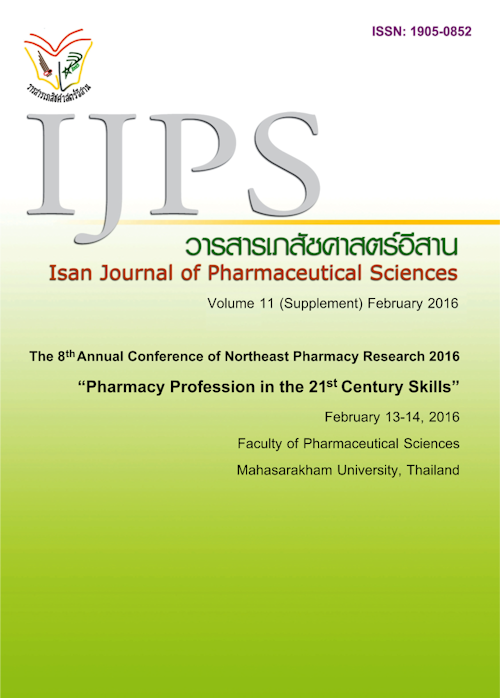The study of factors and components in situ forming gel formulation comprising of PLGA
Main Article Content
Abstract
Introduction: In situ forming gel implants is developed continuously for implant replacement in order
to reduce pain from the administration for periodontitis treatment. Objective: The purpose of this research is
to develop in situ forming gel formulation for implant in periodontitis treatment. Poly(lactic acid-co-glycolic
acid)(PLGA) was dissolved in N-methyl pyrrolidone (NMP) and the in situ gel was formed by solvent
exchange mechanism. The effectof the ratio of PLGA:NMP was studied at ratio 1:2, 1:3, 1:4, 1:5, 1:10
and1:15 and the effect of the additives addition such as polyvinylpyrrolidone (PVP), Poloxamer
407®andPoloxamer 188®was also performed. The physical properties including viscosity, gel forming,
injectability, and weight loss of polymer were evaluated for all formulations. Results:The gel forming and
viscosity of developed gel indicated that the selected ratios for later study were PLGA: NMP ratio at 1:3, 1:4
and1:5 because gel was formed within 1 minute. However, the high viscosity was observed with those ratios
(11.803±1.857Pa.s, 2.576±0.385 Pa.s and 0.955±0.076 Pa.s,respectively). The reduction of viscosity and
injection time and the increasing of polymer weight loss were also observed when the additives were added.It
might be due to the internal porous structure. As SEM micrograph, the internal porous structure was observed
when the additives were added. The addition of either Poloxamer 407® or Poloxamer 188®produced a
consistency porous with a thin wall and smooth surface with tiny pore whilst PVP would produce a fluffy
texture and a smooth surface with a thick wall and also had different size of porous within structure.Moreover,
the polymer weight loss of PLGA/PVP: NMP with ratio at 1:3 was increased dramatically at the first week and
the rate of weight loss was increase slowly to plateau since week 2 to 4 of study (% weight loss from week 1
to week 4; 14.37, 19.83, 18.46 and19.18, respectively).Thus it is predictable that the in situ gel
fromPLGA/PVPmight create a slow release until plateau since week 2 of administration. Conclusion:The
additives such as Poloxamer or PVP are required for in situ gel forming formulation comprising of PLGA with
solvent exchange method to suit for periodontitis treatment application.
Article Details
In the case that some parts are used by others The author must Confirm that obtaining permission to use some of the original authors. And must attach evidence That the permission has been included
References
อรลักษณาแพรัตกุล. เทคโนโลยีการเคลือบทางเภสัชกรรม (Pharmaceutical coating technology). นครนายก: สาขาวิชาเทคโนโลยีเภสัชกรรมคณะเภสัชศาสตร์มหาวิทยาลัยศรีนครินทรวิโรฒ, 2552.
Brodbeck KJ, McHugh AJ. Phase inversion dynamics of PLGA solutions related to drug delivery. J. Control. Release1999; 54: 233-245.
Do MP. In situ forming implants for the treatment of periodontitis. Human health and pathology. Universit e du Droit et de la Sant e - Lille II, 2014.
Setthajindalert O, Phaechamud T. Solvent Exchanged In Situ Forming Gel. Thai Pharm Health Sci J.2012; 7(3):137-142.
Ramchandania M, Robinson D. In vitro and in vivo release of ciprofloxacin from PLGA 50:50 implants. J. Control. Release1998; 54: 167-175.
Thakur R, McMillan H, Jones D. 2014. Solvent induced phase inversion-based in situ forming controlled release drug delivery implants. J. Control. Release 176:8-23.
Vieira M, Silva M, dos Santos LO. Natural-based plasticizers and biopolymer films: A review. Eur. Polym. J. 2011: 47; 254-263
Zeng N, Dumortier G, Maury M, et al. Influence of additives on a thermosensitive hydrogel for buccal delivery of salbutamol: Relation between micellization, gelation, mechanic and release properties. Int. J. Pharm. 2014; 467: 70-83.
Zilberman M, Malka A. Drug controlled release from structured bioresorbable films used in medical devices-A mathematical model. J. Biomed. Mater. Res. Part B Appl. Biomater 2009;89B(1):155-164.


